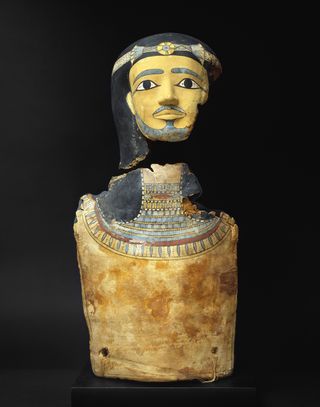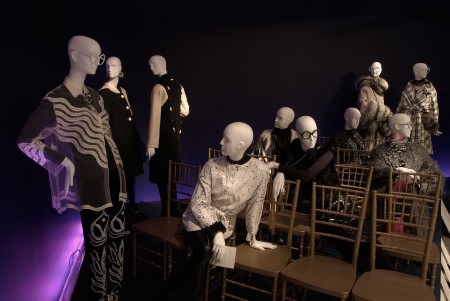Coming Attractions at Museums: October 2009
By Peter Walsh

One of the Secrets in Tomb 10A at the MFA
A Tomb Gets its Time
Forget Indiana Jones. Archaeology is not about the obvious. Case in point: the Museum of Fine Arts’ exhibition, The Secrets of Tomb 10A, opening October 18.
It’s not about a lost Pharaoh (the tomb belonged to a governor named Djehutynakht) or spectacular gold and jewels (grave robbers got the best of the glitter long before the archaeologists arrived). But the tomb, discovered back in 1915 by the prodigious Harvard-MFA Expedition, still had the largest and artistically richest Middle Kingdom burial assemblage yet found, including a now-famous painted coffin, considered among the most beautiful Egyptian objects ever made.
A particularly delightful part of the ensemble is the dozens of intricate, carved wooden models— tiny boats, fully equipped miniature workshops, a procession, and scenes from everyday life on the governor’s estate, meant to keep him in familiar surroundings during the afterlife.
The show, mostly of objects never before seen in public with many freshly conserved, will occupy the MFA’s Gund Gallery for an astonishing seven months– a rare glimpse into the long decades of cataloging, research, and conservation that follow almost any archaeological season.
That is especially true with the extraordinarily rich finds of the Harvard-MFA excavations, which gave Boston one of the world’s greatest collections of Egyptian artifacts. Thousands of pages of field notes remain to be digested and storerooms full of splendid objects, the share of the discoveries granted to the MFA by the Egyptian government, await a second unearthing.
The Anti-Fashionista
Back in 2005, when the Metropolitan Museum of Art featured her in an important exhibition, an obscure New York businesswoman in her mid-80s suddenly became a fashionista icon, lionized in interviews, appearing on best-dressed lists, invited everywhere, and hailed as a major trendsetter perched on the dizzying Heights of Style.
Iris Apfel had never been either a fashion designer or an official arbiter of taste. Instead, she wore things— strange, rococo combinations of things: antique Mexican silver, plastic beads from the ‘50s, great swathes of zebra-striped upholstery fabric from her family business, designer tops over Levi jeans, all finished off with her signature white hair and saucer-sized eyeglasses.

A glimpse of The Rare Bird of Fashion: The Irreverent Iris Apfel
Apfel had been living more-or-less in the worker suburbs of the fashion metropolis for decades. She and her husband ran Old World Weavers, a firm that specialized in custom-made and antique reproduction fabrics, suppliers to high-level interior decoration projects, such as Jackie Kennedy’s White House, and taken up, over the years, by top designers like Oscar de La Renta, Geoffrey Beene, and Bill Blass.
Rare Bird of Fashion: The Irreverent Iris Apfel, a traveling show of some of Apfel’s more dazzling ensembles, opens at the Peabody Essex Museum in Salem on October 17. Now that haut couture is all but dead and even movie stars sport standard models off the rack, it is less a fashion show that a nod to the end of all that.
The visual effect of Rare Bird is part inspired individualism, part eccentric hippie great aunt. Still, Apfel’s style is, for the most part, very put together, if over the top in its simultaneous embrace of and distain for the snooty, class-conscious conventions of fashionability.
Apfel insists that her look was entirely improvised, collaged from fleeting trips to department stores, antique dealers, and flea markets. Yet it is very much part of a contemporary trend which emphasizes a joyful, liberated creativity over the sneering dictates of the professionals. Through February 7.
Out of the East
The young Slovenian artist Tobias Putrih seems a throw-back to the Russian Constructivists, who sometimes turn up in his titles. The boundaries between art, sculpture, architecture, and graphic design are treated as irrelevant, distinctions between high and low art are banished, and, as with his Russian mentors, form often follows idea.
Putrih, who now lives in New York, has been labeled “promising” for several years now. His witty constructions, made from Industrial Age materials as diverse as high-end laminated plywoods, Styrofoam, and egg cartons, have been compared to compared to elegant kids’ playrooms or high-tech toys. They seem a bit too conceptual for some. Their command of sculpture form and presence, though, usually impresses.
Tobias Putrih and MOS, Without Out opens at MIT’s List Center on October 23. It documents his collaboration with “MOS,” a high-tech “collective” of architects and designers whose principals, as with many progressive designers these days, have day jobs in academia. The show features a commissioned work, Without Out, billed as “a large scale sculptural installation whose structural design is premised on its inevitable ruination.” Will the visual or the cerebral hold the crown? You have until January 3 to find out.
Closing in October:

Rona Pondick's sculpture Dog
Rona Pondick: the Metamorphosis of an Object at the Worchester Art Museum through October 11. One of the leading sculptors of the Baby Boom generation appears here in a striking new phase.
A New and Native Beauty: The Art & Craft of Green and Green, at the MFA through October 18. The Green brothers, Charles and Henry, trained in architecture at MIT and roughly contemporary with Frank Lloyd Wright, created buildings and designs that are the crowing glory of the California Arts and Crafts Movement. Their finely conceived and executed work seems more and more universal and timeless with each passing year. This scholarly and visually splendid show reminds us that their original style had some important roots in Boston. Not to be missed.
Tagged: A New and Native Beauty: The Art & Craft of Green and Green, Boston, Charles and Henry Green, Iris Apfel, MIT’s List Center, Museum of Fine Arts, Peabody Essex Museum, Rare Bird of Fashion, Rona Pondick, Russian Constructivists, The Secrets of Tomb 10A, Tobias Putrih, Without Out, modern sculpture, peter-Walsh
